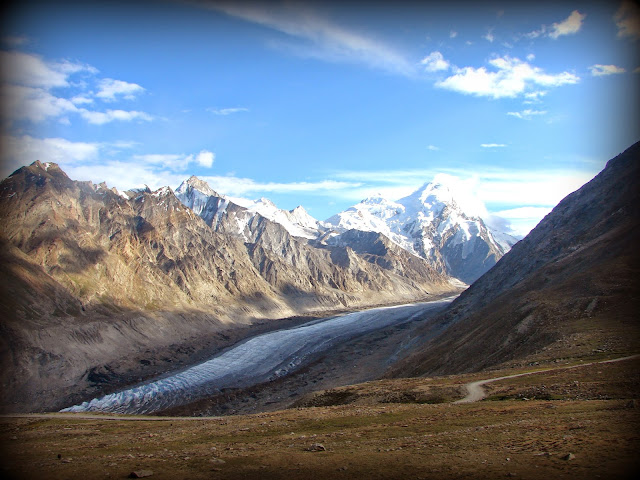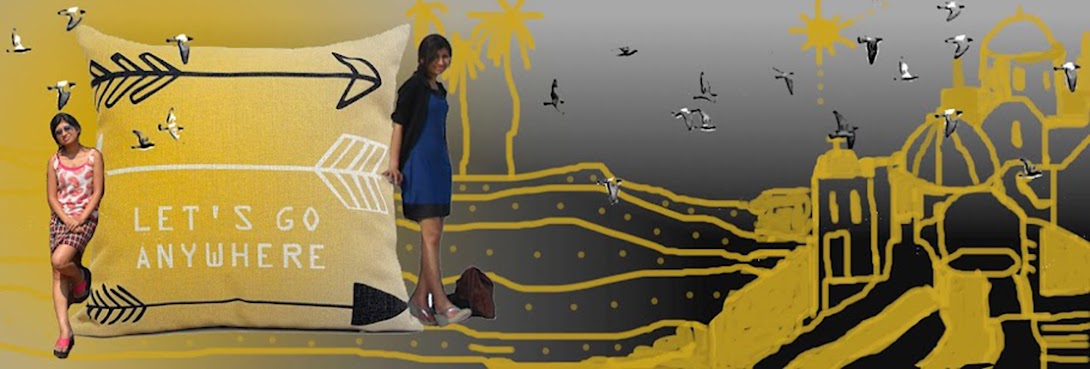 |
| THE DURUNG DURUNG GLACIER PHOTOGRAPHED FROM PENZI LA. In the local language, La means a pass (The photograph was clicked in the month of August) |
Country: India
Union Territory: Ladakh
MAIN CITIES AND TOWNS (one must be acquainted with them to plan the itinerary)
1. Delhi, the Capital of India
2. Leh, Capital of Ladakh
3. Srinagar, Capital of Jammu and Kashmir
4. Kargil, the main junction connecting Srinagar on the west, Leh on the east, and Padum on the south
5. Padum, the administrative center of Zanskar Valley
HOW TO REACH
Route 1:
A direct flight from Delhi to Leh takes around an hour. The ticket prices range from Rs. 5000 to anywhere around Rs. 30,000 (one way) depending on the season (the fares noted here are pre-COVID). (Please note: costs would have changed since I traveled a few years back).
From Leh, one can hire a private taxi or a shared taxi. The taxi can be arranged by a local travel agent or one can go to the taxi stand near the main bus terminus. The shared taxis leave pretty early in the morning around 2:30 am. It is almost an 18-hour journey via Kargil. There are two Taxi unions in this region, hence, there might be a need to change vehicles at Kargil. The Taxi fare varies for local tourists, Indian tourists from other states, and foreign tourists. If you are lucky you can get the local price that's around Rs. 1500 - Rs. 2000. Hiring a private vehicle would definitely amount to at least 5 times that and that's the fare in 2012. There may have been a price hike since then.
There are buses that travel between Leh and Kargil and Leh and Padum but they are irregular and don't run every day. One must visit the bus terminus to inquire about the bus timings. Traveling by bus is the cheapest option and the fares are quite nominal.
For avid trekkers, there are many trekking routes to Zanskar.
1.Trek route from Lamayuru to Padum. (There is a winter trek on the river Zanskar called the Chader trek that starts from Lamayuru and ends at Padum).
2. Trek route from Darcha to Padum
3. And finally one can just follow the road. It will surely lead to someplace amazing :)
Route 2:
Direct flight to Srinagar from Delhi. Take a taxi, private car, or bus to Padum Via Kargil.
To check the various options to reach Leh and Srinagar Click Here
WEATHER and WHAT TO WEAR
 |
| My tanned feet after a month |
Summers are warm during the Day (20-30 C) and cold at night (5-15 C). I was there in the months of August, September, and early October. I needed some light warm clothes for the day. On warmer days cotton wear is the best. In the evenings it would get pretty cold and a jacket or a pullover was a must. It is very dusty and the sun can be pretty strong, so cotton clothes are best suited for the region, with full sleeves, long pants, a stole to cover the head, and a woolen jacket for the evenings. Also, monasteries prefer the legs and arms covered. The nuns and monks will not object openly but I was told by a local that short dresses are considered disrespectful in this region, especially when visiting the gompas (monasteries). Carrying sunshades and sunscreens is strongly advised. Wear covered shoes. The terrain is rough and hence sneakers are the best option.
BEST TIME TO VISIT
Summer is the best time to visit Zanskar. In winter the passes are blocked by snow, thus making traveling extremely difficult, rather impossible. The only way to reach Padum in winter is through the Chadar trek on the frozen Zanskar River starting from Lamayuru. If you are the adventurous kind, I heard this trek is quite a thriller:)
May through early October is fairly a good time to visit Zanskar.
WHERE TO STAY and WHAT TO EAT
Zanskar Valley has options for homestays and the rent is pretty nominal. They provide food as well. The toilet facilities are not the best since they use primitive local toilets but some guest houses and homestays are building proper toilets these days. There is also the option of staying at the monasteries if it is just for a day. The monasteries do not ask for any pay but one can always donate whatever they wish. The monks and nuns are extremely hospitable.
The staple diet there is Thupka (a kind of local pasta) and noodles but rice and lentils are also available. There are no restaurants in the region except in Padum. Options for food are very limited.
ACTIVITIES
If you have some time to spare, about a month or two or more, you can volunteer to teach in a local school or the monasteries. The schools need teachers for English, Hindi, Maths, and Science. There is no formal or official application process. One can just go there and offer to teach. One can also contact organizations like Jamyang and volunteer through them.
Trekking, camping, and river rafting are the main activities there. However, I am not sure how safe it is! The rapids in the Zanskar River range between grades 1 to 5. Probably, if one is a seasoned rafter, knows swimming, and follows all safety protocols, it shouldn't be unsafe.
PLACES TO VISIT
1. Zongkhul Monastery: One of the oldest and most secluded monasteries in Zanskar Valley. A must-visit. It reminded me of the sky caves in Nepal.
 |
| The route to Zongkhul is amazingly beautiful! |
 |
| Zongkhul Monastery |
2. Karsha Monastery: It is the biggest monastery in Zanskar but I did not get the opportunity to visit it.
3. Phuktal Monastery: One of the most spectacular Monasteries in this Valley. It takes a couple of days to trek to reach Phuktal. From Padum one can take a vehicle to the village at Reru (the road ends there). From Reru village, it's a one to two-day trek (with a break) depending on the individual's stamina.
4. Shani Monastery: This is one of the oldest monasteries in Zanskar and has many old statues, wooden carvings, and relics. It can be visited on the way to Zongkhul.
5. Rangdum Monastery: This monastery can be visited on its way to Padum. It is guarded by military forces because of a terrorist attack a few years back.

6. Stongdey Monastery: The second largest monastery in the region. It rests high on the hill and I did not have the opportunity to visit it.
7. Zangla: I stayed at the Zangla Nunnery for 5 weeks and taught the little nuns Maths, Hindi, and English. Unfortunately, 5 weeks were not sufficient to teach much. If there are people who have the time to devout for at least a month and a half please do contact me. The experience cannot be described in words. It has to be felt!
Volunteers come each year to teach them through various NGOs and Buddhist organizations but there is no coordination. There are times these children get a teacher for a month and then have no one for the next few months. Whatever they learn is forgotten and the next volunteer has to start fresh. A few of us are trying to coordinate interested enthusiasts who have the zeal to give these children some valuable time. They are bright kids and would do wonders if well-guided. I must mention that 'It' is not a religious initiative. The idea is 'solely' to 'teach' the kids in this region, where there is a dearth of good well-informed teachers. Please Let me know if you wish to contribute your 'time'! You can email me through the form on the home page. Thanks :)
Volunteers come each year to teach them through various NGOs and Buddhist organizations but there is no coordination. There are times these children get a teacher for a month and then have no one for the next few months. Whatever they learn is forgotten and the next volunteer has to start fresh. A few of us are trying to coordinate interested enthusiasts who have the zeal to give these children some valuable time. They are bright kids and would do wonders if well-guided. I must mention that 'It' is not a religious initiative. The idea is 'solely' to 'teach' the kids in this region, where there is a dearth of good well-informed teachers. Please Let me know if you wish to contribute your 'time'! You can email me through the form on the home page. Thanks :)
The occupation of the villagers here is agriculture. I was there during the wheat harvesting season and got the opportunity to see the entire process. The valley echoes the Zanskari harvest songs around this time of the year.
 |
| The Zangla Palace |
 | |||||
| The Zangla Nunnery |
 |
| From the banks of the Zanskar river |
 |
| Hot springs (it wasn't quite hot and it's more like a mud sauna in the open :) The locals go there to take a dip as they believe this water has medicinal value and cures diseases. |
 |
| THE DURUNG DURUNG GLACIER PHOTOGRAPHED FROM PENZI LA (on my way back in the first week of October) |







